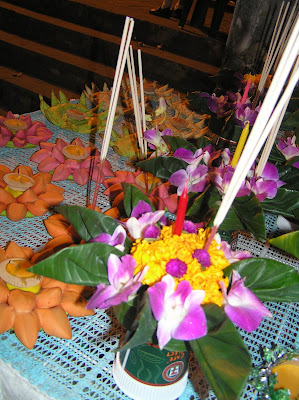The first day of Loi Krathong began for me, at Watt Dok Kham where I helped the women prepare the ingredients for the special food to be cooked by the men that evening.
 |
| Novice "Bomb" stirring the special "celestial" food. |
The ingredients included coconut milk, some 25 pounds of sugar, 20 cans of sweetened condensed milk, brown cane sugar, roasted peanuts, seseme seeds, cinnamon and cooked sticky rice.
It is believed this celestial food was given to the Buddha by a woman, which when he ate, ended the Buddha's period of extensive fasting as the way to enlightenment. The heavenly food is cooked for three to five hours on the night before the full moon, and is eaten on the morning of the full moon.
How did this celestial food taste? Heavenly of course!
Watt Dok Kham in Chiang Mai .... here was where I spent the first day of Loi Krathong. Helping to stir these large wok was a real job! The cooking of the coconut milk started at 7:00 p.m. but the final product was not done until nearly 10:30 p.m.! By the end, stirring as difficult since the consistency of the mixture was that of thick fudge.... heavy.... but one had to keep stirring so the mixture would not burn to the bottom of the wok.













